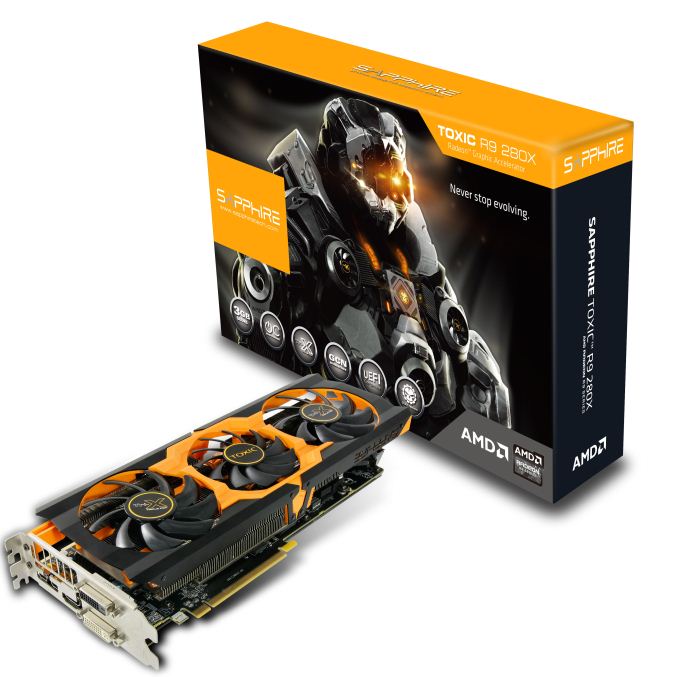The Sapphire R9 280X Toxic Review
by Ryan Smith on October 10, 2013 8:00 AM EST- Posted in
- GPUs
- Radeon
- Sapphire
- Tahiti
- Radeon 200
Final Words
Bringing our review of Sapphire’s R9 280X Toxic to a close, our experience with the card and our results prove that Sapphire has fundamentally achieved what they have set out to do: they’ve put together the fastest R9 280X card. It’s 13% faster than a stock 280X and it’s still 5% faster than the factory overclocked Asus card we looked at earlier this week. Out of the box the Toxic even maintains a hair’s lead over the Asus card when the Asus card is overclocked, which means we’re looking at a card that’s arguably competitive at stock with end user overclocked cards.
With that said while this isn’t necessarily a head-to-head article between the 280X Toxic and the Asus 280X DirectCU II TOP, it’s a logical comparison we have to make given the fact that both are factory overclocked 280X cards shooting for strong out of the box performance. For gaming workloads the 280X Toxic cleanly and clearly beats the Asus card here by a meaningful performance amount. However Asus is absolutely a spoiler here due to their aggressive pricing and their very quiet cooler. Their 280X DCUII TOP can’t match the Toxic, but it’s $40 cheaper and over 5dB quieter. Consequently if all you want is the fastest 280X on the market then Sapphire’s 280X Toxic is clearly the card to get, otherwise the Asus card is worth a consideration for its better price/performance ratio and cooling performance. As is almost always the case for factory overclocked cards there is a price to pay for the very fastest card, both in literal cost and in power and acoustics.
Meanwhile we’ll also quickly point out that the 280X Toxic ends up being faster than a stock GTX 770 by several percent for $50 less. But that’s a tricky comparison at best since we’re now comparing different cooler types (blower versus open air), a significant difference in power consumption, and it doesn’t take into account any of the customized GTX 770 cards. But it’s at least food for thought.
On a final note, since we’re looking at AMD’s second-tier cards – 290X is still due to arrive – given Sapphire’s $349 MSRP any purchasers may want to hold off for a bit until we have pricing and performance information for AMD’s new top-tier lineup. If they were to deliver a strong $400 card then the 280X Toxic likely wouldn’t make as much sense. But that’s something we won’t know for sure until the 290X is launched. It is however something to at least consider given the significant mark-up on the 280X Toxic over a standard 280X.











84 Comments
View All Comments
truprecht - Thursday, October 10, 2013 - link
No, it's clear the Titan should cost less.nathanddrews - Thursday, October 10, 2013 - link
I meant more expensive than the 280X.ShieTar - Thursday, October 10, 2013 - link
Well, nobody who was looking for a good price-performance ratio was choosing the 780 over a 770 anyways, so the 280X really does not change anything here. Let's wait for the 290X and see what happens to the pricing of the 780 and the Titan then.Impulses - Thursday, October 10, 2013 - link
NV said they had no plans to drop the 770's price, I would think a 780 drop is even less probable unless 290X just trounces it... Heck the 280X mostly matches or outperforms the 770 and it's $100 less!I'd been thinking of going NV for my next upgrade (from 2x 6950s), but if AMD can come thru with their frame pacing driver update for Eyefinity in November I'll probably choose AMD again.
EF seems more flexible than Surround anyway, software-config wise.
HisDivineOrder - Thursday, October 10, 2013 - link
nVidia won't admit they're going to do a price drop until they are DOING a price drop. Saying, "Yeah, we're gonna do one. In a few weeks. You know. Once we sell as many GPU's before we have to drop," seems like it'd be stupid to say.just4U - Saturday, October 12, 2013 - link
I really don't know what to make of any of this.. when Nvidia's high end 6x series came out it widely accepted as beating out the 7950-70 yet somehow or another Amd caught up. Than along comes Nvidia's high end 7x series and the 7970GHZ manages to kinda sort of keep pace. Than we have these new cards which are based loosely on the those cards and at stock their coming very close to... I think Anand said within 5% or so. That tells me that there isn't really a huge difference so it will be interesting to see what comes out of amd with their top end cards.It's clear there's no night/day difference so far.. anyone with a good card in the last year and a bit is sort of set for now.
adamantinepiggy - Thursday, October 10, 2013 - link
The article lists this as having "two" dual-link DVI ports. As far as I'm aware, none of the current ATI model video cards have "two" dual-link DVI ports, and issue I ran into when I wanted to drive two big cheap Korean Shimian 2560x1440 monitors that only come with dual link DVI inputs.adamantinepiggy - Thursday, October 10, 2013 - link
Oops, meant AMD video cards, but still think have ATI brand embedded in brain.Ryan Smith - Thursday, October 10, 2013 - link
It's a bit confusing. They're always physically DL-DVI ports; but electrically you're right, they can only drive 1 DL-DVI monitor. I'll go amend that to try to clarify it.commissar0617 - Saturday, October 12, 2013 - link
newegg says 2x dual-link. adamantine is wrong.